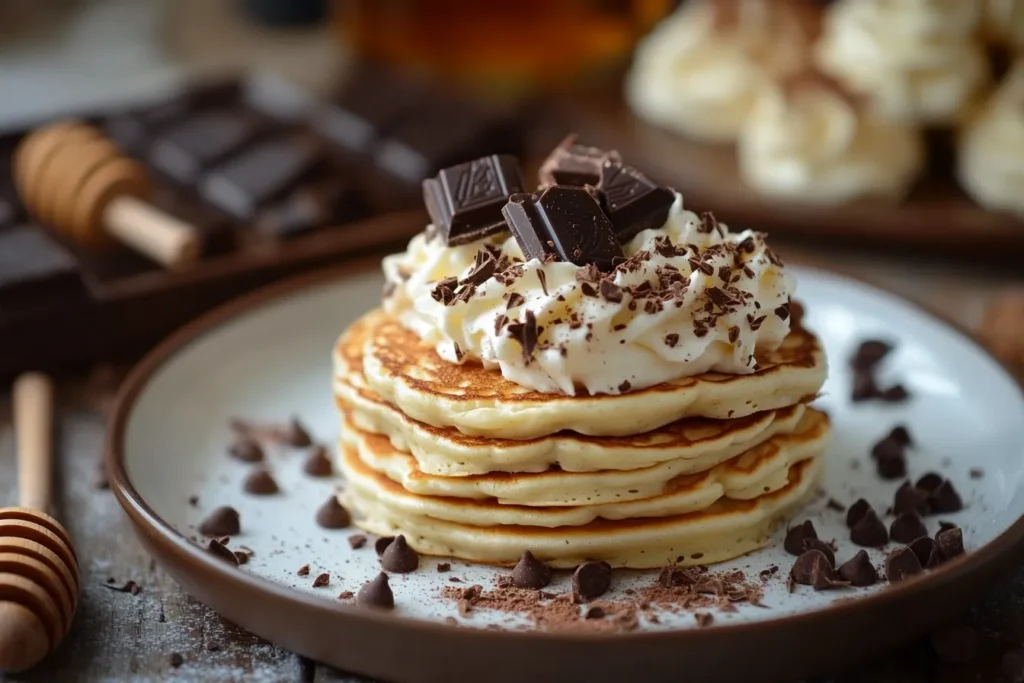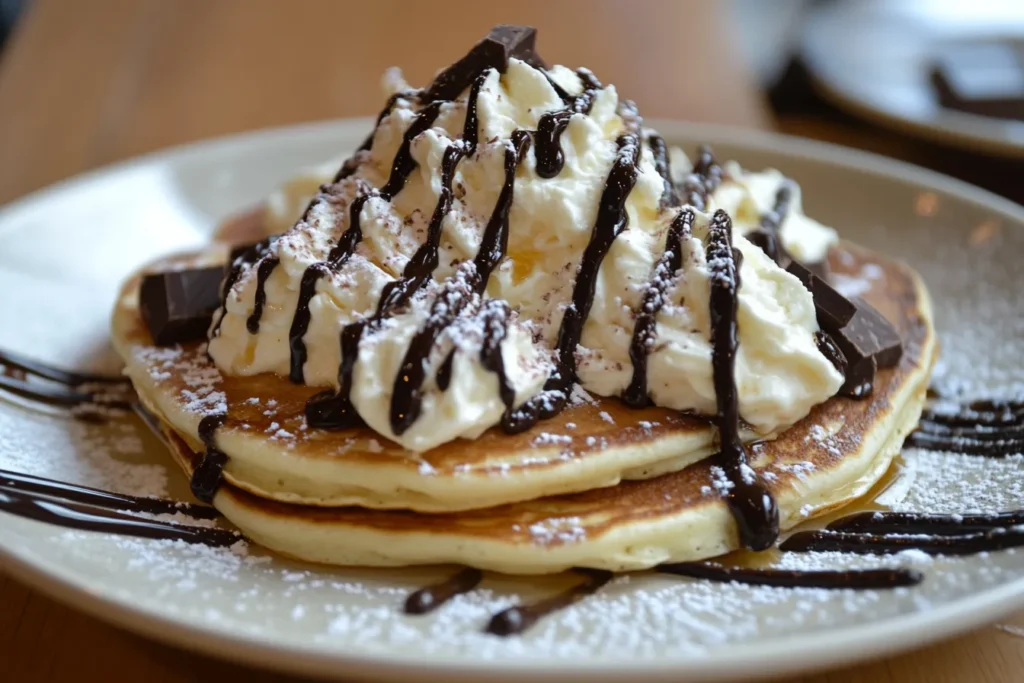Have you ever sat down to a stack of pancakes, drizzled in syrup, and thought, “Are these actually good for me?” It’s a common question, especially if you’re trying to balance enjoying your favorite comfort foods with making healthier choices. The truth is, pancakes can be part of a healthy diet—it all depends on how you make them and what you top them with. If you’ve ever felt guilty about indulging in pancakes or wondered how to make them a little better for you, don’t worry. With a few simple tweaks, you can enjoy your pancakes guilt-free while still fueling your body. Let’s break it down and find the balance between delicious and nutritious!
List Of Contents
What Are Pancakes?
Pancakes are a beloved breakfast staple across the globe. At their core, they are thin, flat cakes made by frying a batter of flour, eggs, and milk. The result is a golden, fluffy treat that pairs well with a variety of toppings. Whether you prefer sweet or savory versions, pancakes are a versatile dish found in nearly every cuisine. Check out more recipes here.
A Brief History of Pancakes
The history of pancakes dates back thousands of years, with evidence of similar dishes appearing in ancient civilizations. From the Roman alita dolcia to the Russian blini, pancakes have evolved into a global phenomenon. Each culture adds its unique twist, whether it’s the use of buckwheat in France’s crêpes or the incorporation of rice flour in Southeast Asian variants.
Basic Ingredients
Common Ingredients in Pancake Recipes
The basic pancake recipe includes a few simple ingredients:
- Flour – Usually all-purpose, though many recipes now use alternatives like almond or coconut flour.
- Eggs – Provide structure and fluffiness.
- Milk or Dairy Alternatives – Create the batter’s liquid base.
- Leavening Agents – Baking powder or baking soda for the signature rise.
- Sweeteners and Oils – Optional additions like sugar and melted butter enhance flavor.
Variations Around the World
Pancake recipes vary significantly across cultures:
- American pancakes: are known for their thick, fluffy texture and are typically enjoyed with a drizzle of syrup.
- French Crêpes: Thin and delicate, perfect for sweet or savory fillings.
- Japanese Soufflé Pancakes: Incredibly airy, almost dessert-like.
- Indian Dosa: A savory option made with fermented rice and lentil batter.
Pancake Nutrition Basics

Macronutrient Profile of Pancakes
A standard pancake primarily contains:
- Carbohydrates: Flour provides the majority of carbs.
- Proteins: Eggs and milk contribute protein, but the amount depends on the recipe.
- Fats: Derived from eggs, butter, and additional oils in the batter.
Calories in a Standard Pancake
A single medium pancake (approximately 4 inches in diameter) contains about 86 calories, but this number skyrockets when toppings like butter and syrup are added. Opting for healthier ingredients can significantly alter the caloric profile. Check out more recipes here.
Common Add-Ons and Toppings
Syrups, Fruits, and Spreads: Health Impacts
Toppings are where pancakes transform from breakfast to indulgence. Maple syrup, while natural, is high in sugar. Alternatives like fresh fruits or sugar-free syrups reduce added sugar intake and increase fiber.
Effects of Processed vs. Natural Ingredients
Natural toppings like berries or honey provide antioxidants and vitamins, while processed spreads often include trans fats and artificial sugars. Choosing wisely makes a substantial difference in overall health. Check out more recipes here.
Why Pancakes Are Considered Unhealthy
Traditional pancakes are often criticized for their high carbohydrate and sugar content, as these can lead to significant blood sugar spikes. Furthermore, many store-bought mixes not only contain preservatives but also include refined ingredients, making them less healthy overall. Check out more recipes here.
Potential Health Benefits of Pancakes
When made with healthier ingredients, pancakes can be a source of:
- Fiber: Whole-grain flours add essential dietary fiber.
- Protein: Adding eggs or a scoop of protein powder increases nutritional value.
- Micronutrients: Incorporating fruits or seeds boosts vitamin and mineral content.
Store-Bought vs. Homemade
Differences in Nutritional Value
Homemade pancakes allow complete control over ingredients, whereas store-bought options often contain hidden sugars and additives. Opt for mixes labeled as “whole grain” or “low sugar” for better choices.
Key Ingredients That Make a Difference
By substituting refined flour with whole-grain or almond flour, and additionally using natural sweeteners such as stevia or mashed bananas, you can dramatically improve the health profile of pancakes. Moreover, these changes enhance both the nutritional value and flavor while reducing unnecessary sugars. Check out more recipes here.
Evaluating Health Concerns
High Sugar Content in Traditional Recipes
Traditional pancake recipes often rely on refined sugar to enhance flavor. While a small amount of sugar may not seem problematic, the real issue lies in the added syrups and sugary toppings that accompany them. For instance:
- One tablespoon of maple syrup adds approximately 52 calories and 12 grams of sugar.
- Store-bought syrups often include high-fructose corn syrup, which is linked to obesity and metabolic disorders.
To mitigate this, using sugar substitutes like honey or erythritol can maintain sweetness without the excess calories.
Impact of Refined Flour and Gluten
Most pancakes are made from refined flour, which has been stripped of its nutrients and fiber. This leads to:
- Rapid blood sugar spikes, causing energy crashes later.
- They provide limited satiety, which can lead to overeating.
For those with gluten intolerance or celiac disease, traditional flour-based pancakes are not an option. Alternatives like almond flour, coconut flour, or oat flour provide a healthier and gluten-free alternative.
Are Pancakes Filling?
Glycemic Index and Satiety Levels
The glycemic index (GI) of pancakes is relatively high due to refined flour, which means they are quickly digested and absorbed. This can cause:
- A short-term energy boost followed by hunger soon after.
- Poor satiety compared to higher-fiber breakfast options like oatmeal.
Adding ingredients like chia seeds or flaxseeds to the batter can lower the glycemic response, keeping you fuller for longer.
Blood Sugar Fluctuations After Consumption
Pancakes, especially when topped with sugary syrups, can lead to sharp blood sugar spikes. Repeated spikes over time can potentially lead to the development of insulin resistance. Opt for:
- Low-GI flours such as buckwheat or whole grain.
- Toppings with healthy fats like nut butter to slow glucose absorption.
Pancakes for Diet Plans

Can Pancakes Be Part of a Weight-Loss Diet?
Pancakes can be included in a weight-loss diet when prepared mindfully. Here’s how:
- Calorie Control: Use smaller portions and high-protein batters to satisfy hunger with fewer calories.
- Healthy Swaps: Replace syrup with fresh berries or Greek yogurt for natural sweetness and added nutrients.
Pancakes for Athletes and High-Energy Diets
Athletes often require carbohydrate-rich meals to effectively fuel their energy needs. Consequently, pancakes can serve as an excellent pre-workout option, especially when thoughtfully paired with complementary nutrients. For instance:
- Protein: Adding a scoop of protein powder to the batter or serving pancakes alongside eggs can significantly boost their protein content.
- Healthy Fats: Toppings such as avocado or almond butter not only enhance flavor but also provide sustained energy for prolonged activity.
Additionally, these nutrient combinations help balance the meal and optimize performance.
Nutritional Customizations
Whole-Grain and High-Fiber Pancake Options
Whole-grain flours, such as spelt, quinoa, or oat flour, significantly improve the fiber content of pancakes. Fiber aids in:
- Better digestion.
- Stabilized blood sugar levels.
- Prolonged satiety.
Adding mix-ins like flaxseeds or psyllium husk boosts both the fiber and omega-3 fatty acid content.
Adding Protein and Healthy Fats
Protein-packed pancakes are easy to make by incorporating:
- Egg whites: A low-calorie, high-protein addition.
- Greek yogurt: Increases creaminess and protein levels.
- Nuts and seeds: Add crunch and healthy fats.
Balancing macronutrients ensures pancakes fuel your body without contributing to weight gain.
Effects of Pancake Toppings
Fruits vs. Processed Sugars
Toppings make or break a pancake’s nutritional profile. Here’s a comparison:
- Fruits: Fresh or frozen fruits like blueberries and bananas provide natural sweetness, antioxidants, and fiber.
- Processed Sugars: Packaged syrups and sweetened spreads are calorie-dense and nutrient-poor.
Choosing fresh or minimally processed toppings significantly improves overall health.
Calorie Density of Popular Toppings
Here’s a breakdown of some common pancake toppings and their calorie impact:
- Butter (1 tbsp): 100 calories.
- Nutella (1 tbsp): 100 calories but high in sugar.
- Fresh Strawberries (1/2 cup): Only 25 calories with added vitamins.
Comparisons to Other Breakfasts
Pancakes vs. Waffles and French Toast
While all three are popular breakfast options, pancakes can be the healthier choice if prepared correctly. Here’s how they compare:
- Waffles: Contain more fat due to the additional butter in the batter.
- French Toast: Slightly higher in protein but often cooked with more butter or oil.
Comparing Pancakes to Oatmeal or Smoothies
- Oatmeal: Higher in fiber and better for heart health.
- Smoothies: Easier to control nutrient density, but can lack satiety compared to solid food.
When enriched with healthy ingredients, pancakes can hold their own against these
Healthier Ingredients
Substitutes for White Flour
The foundation of a pancake’s health profile starts with the flour. Refined white flour, while popular, is nutrient-poor and contributes to rapid blood sugar spikes. Consider these alternatives:
- Whole-Wheat Flour: Adds fiber and essential nutrients like iron and magnesium.
- Oat Flour: Naturally gluten-free, it provides a hearty texture and improves satiety.
- Almond Flour: Packed with protein and healthy fats, making it ideal for low-carb diets.
- Coconut Flour: Low in carbs and rich in fiber, though it requires more liquid for proper consistency.
These flours not only enhance the nutritional value but also cater to specific dietary needs, such as gluten-free or low-carb lifestyles.
Reducing or Replacing Sugar
Traditional pancake recipes call for added sugar in the batter. Here are healthier sweetening options:
- Mashed Bananas or Applesauce: Provide natural sweetness with added vitamins and fiber.
- Honey or Maple Syrup (in moderation): Natural sugars with minimal processing.
- Stevia or Monk Fruit: Zero-calorie options that maintain sweetness without impacting blood sugar.
Reducing sugar is key to making pancakes part of a balanced diet.
Alternative Pancake Recipes

Gluten-Free Pancake Recipes
For those with gluten intolerance or celiac disease, gluten-free pancakes are a lifesaver. Popular options include:
- Rice Flour Pancakes: Light and fluffy, with a neutral taste.
- Buckwheat Pancakes: Despite the name, buckwheat is gluten-free and high in nutrients like magnesium.
- Chickpea Flour Pancakes: Higher in protein and ideal for savory preparations.
Keto and Low-Carb Pancakes
Low-carb lifestyles demand a different approach to pancakes. Recipes may use:
- Almond or Coconut Flour: Low in carbs and high in healthy fats.
- Cream Cheese Pancakes: A blend of eggs, cream cheese, and a touch of almond flour creates a keto-friendly option.
These alternatives ensure that everyone, regardless of dietary restrictions, can enjoy pancakes.
Cooking Techniques
Baking vs. Frying Pancakes
The method of cooking can dramatically alter the health profile of pancakes:
- Frying: Traditional preparation uses butter or oil in a skillet, adding unnecessary fats.
- Baking: Baking pancake batter on a sheet pan eliminates the need for added fats, creating a lighter dish.
Tips for Reducing Oil Usage
If frying is preferred, use a non-stick skillet and minimal oil. Consider:
- Spray Oils: Allow precise control over the amount used.
- Alternatives like Ghee or Coconut Oil: Provide healthier fats without compromising flavor.
Portion Control Tips
Appropriate Serving Sizes
A common pitfall with pancakes is overindulgence. Stick to:
- 3-4 small pancakes per serving.
- Pair with nutrient-dense sides like fresh fruit or a boiled egg to round out the meal.
Balancing Pancakes with Other Foods
To create a more balanced breakfast, complement pancakes with:
- Protein: Greek yogurt or scrambled eggs.
- Healthy Fats: Avocado slices or a handful of nuts.
- Vegetables: A side of spinach or a veggie-packed smoothie balances the meal.
Balancing the Plate
Incorporating Vegetables and Proteins
Adding vegetables to your pancake mix can enhance both flavor and nutrition. Examples include:
- Grated Zucchini or Carrot: Adds moisture, fiber, and subtle sweetness.
- Spinach or Kale Puree: Creates a vibrant, nutrient-rich batter.
For protein, try mix-ins like:
- Cottage Cheese: Blends seamlessly into the batter.
- Egg Whites: Lightens the batter and boosts protein content.
Pairing Pancakes with Low-Calorie Drinks
To avoid adding unnecessary calories, pair pancakes with beverages like:
- Herbal Tea or Black Coffee: Zero calories and rich in antioxidants.
- Infused Water: Adds flavor without sugar.
Lifestyle Considerations
Pancakes for Special Diets (Vegan, Paleo)
Meeting specific dietary needs is easier with customized recipes:
- Vegan Pancakes: Use flaxseeds or chia seeds mixed with water as an egg replacement. Non-dairy milks like almond or soy work perfectly.
- Paleo Pancakes: Almond or cassava flour and coconut milk are common ingredients for a grain-free batter.
These adaptations make pancakes accessible to a wide range of diets.
Pancakes for Children: Healthier Options
Children love pancakes, but they often come with sugary toppings. Healthier ideas include:
- Mixing Pureed Vegetables: Sweet potato or pumpkin puree enhances both flavor and nutrition.
- Natural Sweeteners: Use a drizzle of honey or mashed berries instead of syrup.
Long-Term Effects
Health Impact of Regular Pancake Consumption
Consuming pancakes regularly can be part of a balanced diet if prepared thoughtfully. However, consistently eating high-sugar, refined versions may lead to:
- Weight gain.
- Blood sugar imbalances.
- Reduced nutrient intake compared to other breakfast options.
How to Enjoy Pancakes in Moderation
To make pancakes a sustainable part of your diet:
- Limit consumption to once or twice a week.
- Always balance them with protein and fiber-rich sides.
- Choose healthier cooking methods and toppings.
More FAQs: Are Pancakes Healthy?
- Are pancakes bad for weight loss?
Not necessarily. Opt for smaller portions and nutrient-dense ingredients to keep them diet-friendly. - What are the healthiest pancake toppings?
Fresh fruits, nut butter, and Greek yogurt are excellent choices. - Can diabetics eat pancakes?
Yes, with modifications like using almond flour and sugar-free toppings. - Are gluten-free pancakes healthier?
They can be, especially when made with nutrient-rich flours like buckwheat or almond flour. - What is the best flour substitute for pancakes?
Whole-grain, almond, or oat flour are nutritious alternatives. - How many pancakes should I eat in one serving?
3-4 small pancakes, paired with healthy sides, is a reasonable portion. - Can pancakes be meal-prepped?
Yes, freeze batches and reheat them for busy mornings. - What’s the best oil to cook pancakes?
Use coconut oil or ghee for healthier frying options. - Are protein pancakes worth it?
Absolutely, especially for athletes or those needing a protein boost. - Can I eat pancakes every day?
While possible, it’s better to enjoy them occasionally and focus on variety in your diet.
